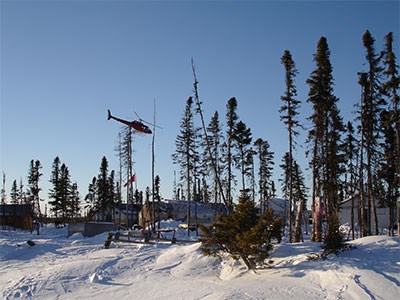The CEO of the Matawa First Nations is disappointed that the Trudeau government isn’t into mining in the Ring of Fire, at least not according to this year’s federal budget.
Though David Achneepineskum is “pretty happy” with the $8.4 billion in planned spending to improve First Nations’ education, on-reserve water quality, social and healthcare infrastructure across Canada over the next five years, it was a headscratcher to him that nothing was laid out to move the undeveloped mineral belt forward.
Despite the Wynne government having a far friendlier government in Ottawa to deal with, their federal Liberal counterparts chose not to match Ontario’s $1-billion pledge for mining-related infrastructure in the James Bay region.
“Certainly I was disappointed there was no mention of the Ring of Fire in the budget at all, whether it’s today or whether they’re thinking about it in the future,” said Achneepineskumm, the head of a tribal council of nine Ojibway and Cree communities, which would be most impacted by mine development. “At least they could say, we’re going to be working with Ontario and the First Nations in the Ring of Fire development.”
He wants further studies done on infrastructure development and environmental safeguards, and how Matawa can get involved with the economic and business opportunities generated from mining that are going to be available.
“I knew it was about time,” said Achneepineskum of the federal government’s approach, “but certainly I’m hoping that in the next several budgets at least the tone will change.”
There have been indications for months that the Trudeau government was planning to pivot funding dollars away from industry infrastructure toward community and individual quality of life projects.
A PowerPoint presentation obtained by Northern Ontario Business that was prepared by federal Ring of Fire executive coordinator Christopher Cornish after the Oct. 19 election suggested funding be allocated to more foundational supports in the Matawa communities.
“With the downturn in the mining cycle, now is the time to focus our efforts on well-being, while continuing to support mining and business readiness, and increase our regional development effort,” it read.
Since 2010, Cornish documented that Ottawa has invested $6.2 million into the Matawa communities under the Strategic Partnerships Initiative. Most of that money has been geared toward getting individuals and communities ready for mining and business opportunities.
Cornish relayed to higher-ups in the government that the Matawa First Nations “have identified a need to pay more attention to individual and community well-being as an important first step in being prepared for future development.”
His suggested a three-year plan involving community well-being pilot projects; financial management capacity-building; attention being focused on water, housing and on-reserve land-use planning; individual social-to-workforce development; a single-window funding approach; and formalizing the process of government-to-government dialogue.
Achneepineskum said his chiefs plan to lobby the federal ministers to bring more attention to the Ring of Fire and boost its national profile.
“We’re hoping that new Liberal government will reconsider and shortly move forward on putting the Ring of Fire development as one of the major priority projects across Canada.”
Achneepineskum said the chiefs and the communities fully support the Ring’s development for the all-weather roads, power and broadband networks, skill training and job opportunities that would come with it. “But we want to ensure that the lands, water and environment are protected. That’s our foremost priority.”
Moreover, he wants faster action by federal bureaucrats in rolling out dollars to fix dilapidated schools and install clean drinking water systems in places like Neskantaga, which has been under a boil water advisory for 25 years.
“That’s fine when promises are made but the actual implementation sometimes takes more than 12 months before it’s finally realized.”
Based on waiting lists for housing and the lack of water and sewer capacity to expand communities, Achneepineskum estimates “within Matawa itself, you’re probably looking at more than $1 billion in terms of community infrastructure.”
At the same time, Matawa is negotiating with Ontario on a regional framework agreement for the Ring of Fire covering environmental protections, regional infrastructure, healthcare initiatives, and resource revenue sharing.
Achneepineskum expects that process to take another two years before any workable plans are put forward.
“There are immediate issues we need to work on before there are shovels in the ground, and that is community infrastructure like housing, water and sewer.”
Federal infrastructure dollars will certainly help in that respect, but he’d like to see Queen’s Park contribute money as well.




